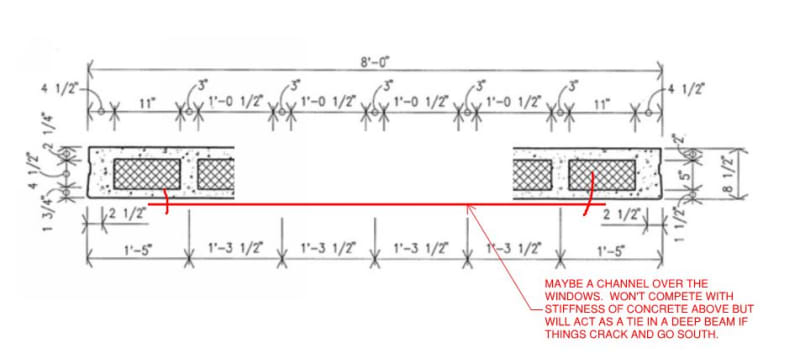I am working on a project where the owner would like to turn an existing single story warehouse into a multi-story office building that has existing insulated precast panels around the exterior. Based on the GPR, the panel has a very similar profile to the attached image. Where the existing openings are or relatively heavy loads are attached, the panels are grouted from bottom of opening or connection to top of foundation. In hollow core panels, I have specified a very similar detail, but I have never retrofitted an insulated precast panel:
1. Is there any other way to remove the insulation for grout besides cutting the inside face shell, removing the insulation and filling everything with grout? - I believe independent framing systems could be a better option if there is not other way.
2. The second floor windows are not too concerning as there will be a rigid diaphragm below the opening which will redistribute the in plane and out of plane loads in the panel. However, the first floor windows will have point loads and roughly half of the lateral load a few feet above the opening. If the panel doesn't have sufficient capacity, is there another option of reinforcing the panel besides filling the cores with grout?
3. My initial concept is to have a channel or HSS member for the lintel and sill with a plate welded at each end parallel to the member and bolted into the nearest core outside of the window which would be filled with grout. Is there a more efficient lintel design that allows for the lateral in-plane moment to not cause cracking at the corners of the new openings?
1. Is there any other way to remove the insulation for grout besides cutting the inside face shell, removing the insulation and filling everything with grout? - I believe independent framing systems could be a better option if there is not other way.
2. The second floor windows are not too concerning as there will be a rigid diaphragm below the opening which will redistribute the in plane and out of plane loads in the panel. However, the first floor windows will have point loads and roughly half of the lateral load a few feet above the opening. If the panel doesn't have sufficient capacity, is there another option of reinforcing the panel besides filling the cores with grout?
3. My initial concept is to have a channel or HSS member for the lintel and sill with a plate welded at each end parallel to the member and bolted into the nearest core outside of the window which would be filled with grout. Is there a more efficient lintel design that allows for the lateral in-plane moment to not cause cracking at the corners of the new openings?

